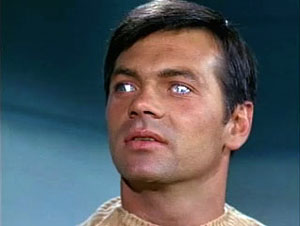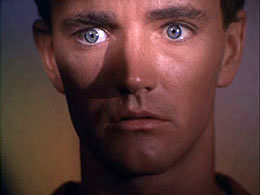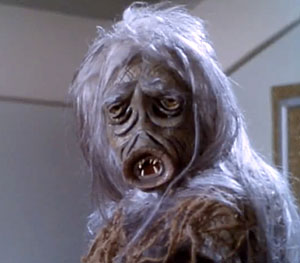 The third episode, “Where No Man Has Gone Before“, is the second one produced, and was actually a second pilot for the series, so we are missing a couple of regulars in Uhura and, importantly, Dr McCoy. The other thing you notice instantly is that the Enterprise crew uniforms are of an older style, slightly baggy, with little turtleneck collar thingies. And then there’s Spock, whose eyebrows are extremely severe and upswept – the make-up would be toned down slightly later. We also get the first mention of Spock’s family background, with the fact that his alien father married a human coming up in conversation.
The third episode, “Where No Man Has Gone Before“, is the second one produced, and was actually a second pilot for the series, so we are missing a couple of regulars in Uhura and, importantly, Dr McCoy. The other thing you notice instantly is that the Enterprise crew uniforms are of an older style, slightly baggy, with little turtleneck collar thingies. And then there’s Spock, whose eyebrows are extremely severe and upswept – the make-up would be toned down slightly later. We also get the first mention of Spock’s family background, with the fact that his alien father married a human coming up in conversation.
The 1960s intrudes on the science fiction with mention of books being stored on “tapes”. This also came up in “Charlie X”, when Charlie first arrives on board the Enterprise and someone says that they have plenty of “entertainment tapes” to keep him amused. And you notice that when books (and medical records of crew) are displayed on viewscreens, they look like microfiche readers, rather than modern display screens. Obviously this couldn’t really be helped making a TV show in the 60s, but it’s still amusing.
This episode also provides an example of reality overtaking the science fiction future. Gary Mitchell and Dr Elizabeth Dehner share a romantic moment over a sonnet “written on the Canopius planet in 1996”. I wonder if in the mid-60s people really thought that humans would be colonising other planets before the end of the 20th century. Sorry, guys!
The plot of this episode is another “human turns into godlike being”, which is a bit unfortunate, because it follows hot on the heels of “Charlie X” in the episode release chronology, making two episodes in a row with a similar main plot. However, this episode has one of the coolest pieces of background matte art in any episode of Star Trek: the painting of the lithium cracking station on Delta Vega. That painting alone makes this episode worth watching. But you’ll notice one thing on it is the pentagonal door archway. While they look cool, pentagonal doorways are rather silly, as demonstrated when a couple of crew members have to duck under the sloping edges to avoid banging their heads.
And last but not least, we have the first fist fight in which Kirk’s shirt gets ripped! Not content with fighting a mere man, Kirk takes on his old friend Gary Mitchell, who has been transformed into a god-like being with enormous reality-altering powers. No need to tell you who prevails. Although with his powers Mitchell does generate a grave for Kirk, complete with headstone, on which we see the name “James R. Kirk”. I guess Gary wasn’t close enough of a friend to know that Kirk’s middle name would later be revealed to be Tiberius. (It hadn’t been decided when this episode was written.)
Body count: Entire crew of SS Valiant (at least 7 people), 9 unspecified casualties during Enterprise‘s encounter with the Galactic barrier, navigator Lieutenant Kelso (strangled by a cable psychicly wielded by Mitchell), Gary Mitchell (punched out by Kirk and buried in Kirk’s grave), Dr Elizabeth Dehner.
Tropes: Humans Are Psychic In The Future, Glowing Eyes Of Doom, Psychic Powers, Science Marches On, A God Am I, Zeerust, Raygun Gothic, Self Destruct Mechanism, Good Old Fisticuffs, Clothing Damage, Did You Just Punch Out Cthulhu.
(Image © 1966 Paramount Studios, used under Fair Use.)

 The second episode aired (but the 8th produced) is “
The second episode aired (but the 8th produced) is “ Rummaging through my DVDs last night looking for something to watch in the hour before bedtime, I decided it was time to start rewatching the original run of Star Trek again. And what better way to celebrate than by blogging a few comments on every episode as I watch it? I’m sure there are dozens of people doing the same thing, but why let a little thing like that stop me?
Rummaging through my DVDs last night looking for something to watch in the hour before bedtime, I decided it was time to start rewatching the original run of Star Trek again. And what better way to celebrate than by blogging a few comments on every episode as I watch it? I’m sure there are dozens of people doing the same thing, but why let a little thing like that stop me?